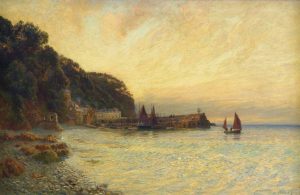
Clovelly Viewed From The North Beach, 1906. Oil. By Fritz Althaus. Image courtesy of Bonhams.
Threading together the life story of Frederick Kerr, prolific marine artist who anglicised his name during the Great War, By James Brewer
Intriguing details are gradually coming to light about a talented painter who just over a century ago made a name for himself with canvases in oil, pastel and mainly watercolours of marine subjects and landscapes in the southwest of England.
Devon and Cornwall maritime scenes painted by Friedrich Bernhard (Fritz) Althaus aka Frederick Kerr (1863-1962) who worked in those counties and in Cambridgeshire were on many occasions selected for Royal Academy shows.
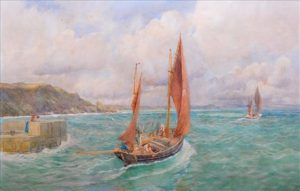
A Mevagissey Trawler. Watercolour. By Fritz Althaus. Image courtesy of Dreweatts & Bloomsbury Auctions.
Nicholas Clark, an international trade specialist based in southeast England, has been conducting research into the life of the artist, his curiosity having been aroused by a tenuous family connection (Mr Clark’s grandmother’s father, Frederick Tate, had provided an accommodation address for the artist’s submissions to the Royal Academy Summer Exhibitions in 1906 and 1907, and there is an Althaus painting in the Clark family).
Mr Clark said that his research had proved fascinating, and depending on progress, he may collate the information into a book. “At least my work to date has enabled links to be achieved such as meeting his family (grandchildren), putting his name change in 1914 into perspective and finding out about a concentration of artists who used to gather around St Ives, Cambridgeshire, ” said Mr Clark.1 He is not the only one interested in Fritz Althaus. Researchers at the Hypatia Trust sought out new information on Althaus when compiling their Cornwall Artists Index: their work enabled further progress to be made by Mr Clark and fed back into their database. As a result probably the best biographical profile on Althaus available is on the Cornwall Artists Index website http://cornwallartists.org/
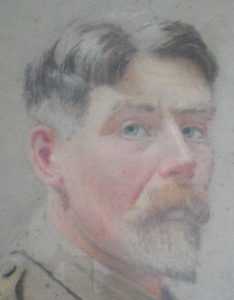
Frederick Kerr (Fritz Althaus). Self-portrait painted in 1917 (aged 54). Courtesy of Kerr family.
Fritz Althaus was born in Lewisham, Kent. His father and two uncles migrated to England after the 1848 revolutionary upheaval in Germany. They were well educated and became celebrated in their fields of music, language and medicine. Althaus’s father was a professor of music, and his mother, an amateur portrait painter, encouraged the son to draw. After early study with the renowned Axel Herman Haig, an artist who boarded with the family, he attended St Martin’s School of Art, the Westminster School of Art and the Royal Institution. Moving to the West Country, he wandered the coasts and the Channel Islands, becoming a prolific marine painter. Up to 1900, he had more than 50 oils and watercolours to his name. Almost all of his 18 Royal Academy exhibits were sea pictures, including Cornish Luggers running for Shelter (1888).
Around 1905 to 1907 a sea change occurred in the life of Althaus. The volume of painting appears to decline, and in 1907 at the age of 44, he married Margaret Henderson, who was known to him or at least his family for many years as she is recorded in the 1891 census as staying at his parents’ home, when aged 18. His new married status seems to have set new priorities for him, and he took up a post teaching art at Leeds High School, which opened in 1907. From that time, his focus became his teaching and his family: there were two sons. Painting continued to be his passion but there was no significant commercial output. Althaus was an accomplished painter in pastel, including portraits. One of his marine works in pastel is Evening on the Exe at Lympstone.
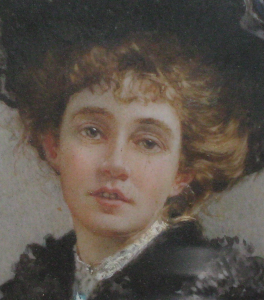
Margaret Kerr (Althaus) née Henderson. By Fritz Althaus. Possibly around 1891. Courtesy of Kerr family.
Following the outbreak of the Great War and atrocities reported in Belgium and elsewhere, anti-German sentiment flared in Britain. Levels of hatred must have been strong enough in Leeds for Althaus to feel it necessary, in November 1914, to change his name to Frederick B Kerr. Other members of the Althaus family who had remained in London were seemingly less pressured, and indeed an Althaus served in the British Army. Some authorities (Mallalieu) indicate that Althaus became a professor of art at Leeds University, but his death certificate suggests he remained a schoolmaster until he retired, living at Camberley, Surrey.
In her book Artists along the Ouse 1880-1930 Bridget Flanagan writes that just as the artists’ colony at St Ives in Cornwall was celebrated, the Cambridgeshire St Ives had its own flowering of artistic talent from the 1880s to the 1930s. Althaus was among those who painted in the latter location, making his way there to paint along the river over at least three decades.
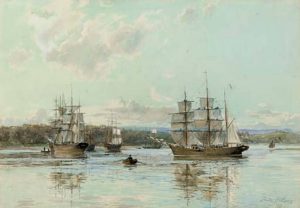
Trading Vessels at Their Anchorage 1893. Watercolour. By Fritz Althaus.© Christies Images Ltd 2007.
Mr Clark (who is a Fellow of the Institute of Export) has been combing through catalogues at the Royal Academy to track down works by Fritz/Fred. His main current goal is to fill in details in respect of his subject’s education – scholastic, academic and in art – and on his life more generally.

Evening On The Exe At Lympstone 1898. Pastel. By Fritz Althaus. First sold through Eland’s Gallery in Exeter. Image courtesy Bearnes Hampton Littlewood.
He recently discovered an archive that revealed that Fritz played the cello in concerts in Exeter with his sister Kitty and his brother Basil, and that refers to many gallery exhibitions. Mr Clark is keen to hear from anyone who can throw further light on the life and times of this remarkable artist, and can be contacted at nichrisint@aol.com.
1We are grateful to Mr Clark for providing much of the background material to this article.





